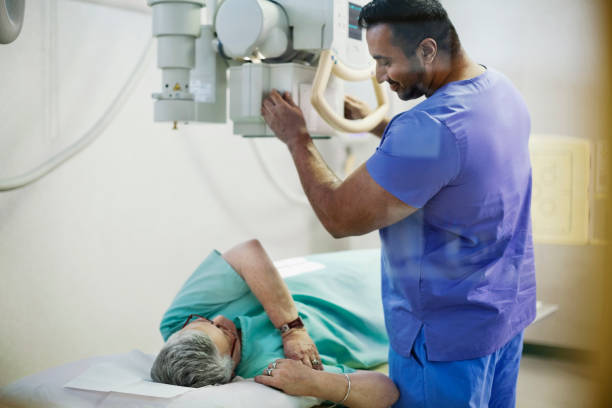28 Careers Related to Radiography
Radiography is a vital field in medical imaging, enabling healthcare professionals to diagnose and treat various diseases using advanced imaging technology. With rapid advancements in medical technology, careers in radiography have expanded beyond traditional X-ray technicians to include specialties in MRI, CT scans, nuclear medicine, and even research.
If you’re interested in pursuing a career in radiography, here’s a detailed breakdown of 28 careers in this field, including job descriptions, educational requirements, and job prospects.
28 Careers Related to Radiography
1. Radiologic Technologist (Radiographer)
Role: Performs diagnostic imaging procedures such as X-rays, MRIs, and CT scans to assist physicians in diagnosing conditions.
Education: Associate’s or bachelor’s degree in radiologic technology; certification may be required.
Job Outlook: High demand due to the essential role of medical imaging in healthcare.
2. X-ray Technician
Role: Operates X-ray machines to capture images of bones and tissues for diagnosis.
Education: Certificate or associate degree in radiologic technology.
Job Outlook: Steady demand as X-rays remain a fundamental diagnostic tool.
3. MRI Technologist
Role: Specializes in operating Magnetic Resonance Imaging (MRI) scanners to produce detailed images of organs and tissues.
Education: Associate or bachelor’s degree with MRI certification.
Job Outlook: Growing demand as MRI technology becomes more widely used.
4. CT (Computed Tomography) Technologist
Role: Uses CT scanners to create cross-sectional images of the body for diagnostic purposes.
Education: Associate degree with additional CT certification.
Job Outlook: High demand, especially in trauma and emergency departments.
5. Ultrasound Technologist (Sonographer)
Role: Uses high-frequency sound waves to create images of internal organs, commonly used in pregnancy and cardiac evaluations.
Education: Associate or bachelor’s degree in sonography.
Job Outlook: Rapid growth due to increasing use in diagnostic imaging.
6. Nuclear Medicine Technologist
Role: Administers radioactive drugs and operates imaging equipment to detect abnormalities in organs and tissues.
Education: Associate or bachelor’s degree in nuclear medicine technology.
Job Outlook: Increasing due to advancements in nuclear medicine.
7. Interventional Radiologic Technologist
Role: Assists in minimally invasive procedures such as angioplasty and stent placement using real-time imaging guidance.
Education: Bachelor’s degree in radiologic science with specialization.
Job Outlook: High demand in surgical and cardiovascular settings.
8. Mammography Technologist
Role: Specializes in imaging the breast using mammography machines to detect cancer and other abnormalities.
Education: Associate or bachelor’s degree with mammography certification.
Job Outlook: High demand due to increased focus on early breast cancer detection.
9. Radiation Therapist
Role: Works with oncologists to administer radiation treatments for cancer patients.
Education: Associate or bachelor’s degree in radiation therapy.
Job Outlook: Growing due to increasing cancer treatment options.
10. DEXA (Bone Densitometry) Technologist
Role: Uses specialized X-ray technology to measure bone density and assess osteoporosis risk.
Education: Certification in bone densitometry.
Job Outlook: Increasing due to the aging population.
11. Cardiovascular Technologist
Role: Specializes in imaging the heart and blood vessels using ultrasound and X-ray equipment.
Education: Associate or bachelor’s degree in cardiovascular technology.
Job Outlook: High demand in cardiology centers and hospitals.
12. Vascular Sonographer
Role: Uses ultrasound to evaluate blood flow and detect vascular diseases.
Education: Associate or bachelor’s degree in vascular sonography.
Job Outlook: Growing demand in cardiology and vascular medicine.
13. Fluoroscopy Technologist
Role: Operates fluoroscopy equipment to capture real-time moving images of internal organs during procedures.
Education: Additional certification in fluoroscopy after radiologic technology training.
Job Outlook: Growing due to its role in surgical and diagnostic procedures.
14. Radiology Assistant (RA)
Role: Works under radiologists to perform advanced imaging tasks and initial diagnoses.
Education: Bachelor’s or master’s degree in radiology assisting.
Job Outlook: Growing as radiologists seek support in workload management.
15. Medical Imaging Technologist
Role: Covers multiple imaging modalities, including X-ray, MRI, CT, and ultrasound.
Education: Bachelor’s degree in medical imaging science.
Job Outlook: High demand as hospitals seek multi-skilled imaging professionals.
ALSO READ: 24 Careers Related to Psychology
16. Veterinary Radiologic Technologist
Role: Specializes in imaging procedures for animals in veterinary clinics.
Education: Associate or bachelor’s degree in veterinary radiology.
Job Outlook: Growing due to increased pet healthcare awareness.
17. Radiology Educator
Role: Teaches and trains future radiographers in academic institutions.
Education: Bachelor’s or master’s degree in radiologic education.
Job Outlook: High demand in medical schools and colleges.
18. Radiology Department Manager
Role: Oversees daily operations of radiology departments, managing staff and equipment.
Education: Bachelor’s or master’s degree in healthcare administration.
Job Outlook: Strong demand in hospital and clinic management.
19. Research Radiographer
Role: Conducts research to develop new imaging technologies and improve diagnostic accuracy.
Education: Master’s or Ph.D. in radiology or medical physics.
Job Outlook: Growing in academic and research institutions.
20. PACS Administrator
Role: Manages the Picture Archiving and Communication System (PACS) used for storing and accessing medical images.
Education: IT degree with radiology knowledge.
Job Outlook: High demand as hospitals go digital.
21. Teleradiology Specialist
Role: Reads and interprets radiographic images remotely for hospitals and clinics.
Education: Radiologic training with IT knowledge.
Job Outlook: Growing due to telemedicine expansion.
22. MRI Safety Officer
Role: Ensures safety protocols are followed when using MRI machines.
Education: MRI certification with safety training.
Job Outlook: Increasing due to patient safety concerns.
23. Radiology Sales Representative
Role: Sells radiology equipment and technology to hospitals and clinics.
Education: Business degree with radiology experience.
Job Outlook: High demand in medical sales.
24. Medical Physicist
Role: Works with radiation therapy and imaging technology to optimize patient safety and treatment effectiveness.
Education: Master’s or Ph.D. in medical physics.
Job Outlook: Strong demand in cancer treatment and diagnostics.
25. Radiation Protection Specialist
Role: Ensures safety in radiology departments by minimizing radiation exposure.
Education: Bachelor’s degree in radiologic science with radiation safety training.
Job Outlook: Growing with increased safety regulations.
26. Biomedical Engineer (Radiology Equipment Specialist)
Role: Designs and maintains radiology equipment.
Education: Engineering degree with medical specialization.
Job Outlook: High demand as imaging technology advances.
27. Radiologic Informatics Specialist
Role: Integrates IT and radiology for digital imaging solutions.
Education: Radiologic or IT degree with informatics certification.
Job Outlook: Growing with advancements in AI and imaging software.
28. Traveling Radiologic Technologist
Role: Works in different locations temporarily, filling staffing shortages.
Education: Radiologic technology degree with state licensure.
Job Outlook: High demand for flexible medical staffing.
Frequently Asked Questions – FAQs
In this section, I will provide you with FAQs and answers on “Careers Related to Radiography”.
1. What is radiography?
Radiography is a medical imaging technique used to diagnose and treat diseases using X-rays, MRI, CT scans, ultrasound, and other imaging technologies.
2. What careers can I pursue in radiography?
You can become a radiologic technologist, MRI technologist, CT scan technologist, ultrasound sonographer, nuclear medicine technologist, interventional radiographer, radiation therapist, and more.
3. Do I need a degree to work in radiography?
Yes, most radiography careers require at least an associate degree, while some advanced roles require a bachelor’s or master’s degree in radiologic sciences.
4. How long does it take to become a radiologic technologist?
It typically takes 2-4 years to become a radiologic technologist, depending on whether you pursue an associate’s or bachelor’s degree in radiologic technology.
5. What is the highest-paying career in radiography?
Some of the highest-paying radiography careers include:
- Radiation Therapists
- MRI Technologists
- Nuclear Medicine Technologists
- Interventional Radiologic Technologists
- Medical Physicists
6. Is radiography a good career choice?
Yes! Radiography is a growing field with high job demand, competitive salaries, and diverse career paths in hospitals, diagnostic centers, and research.
7. Can I specialize in more than one imaging modality?
Yes, you can obtain certifications in multiple imaging techniques like MRI, CT, ultrasound, and nuclear medicine to increase your job opportunities and salary potential.
8. What is the difference between a radiologic technologist and a radiologist?
- Radiologic Technologist: Operates imaging equipment to capture images for diagnosis.
- Radiologist: A medical doctor who interprets radiographic images and provides diagnoses.
9. What skills are needed for a career in radiography?
- Technical proficiency in operating imaging machines
- Attention to detail
- Strong communication and patient care skills
- Problem-solving abilities
- Knowledge of radiation safety protocols
10. Do radiographers work night shifts or weekends?
Yes, especially in hospitals and emergency departments, where imaging services are needed 24/7. Some roles in private clinics may have more stable work schedules.
11. Can I work abroad as a radiographer?
Yes, radiographers are in high demand worldwide. However, you may need to obtain additional certifications or licenses depending on the country.
12. Is a license required to work as a radiologic technologist?
Yes, in most countries, you must pass a certification exam (like the ARRT in the U.S.) and obtain a state license to practice.
13. What are the risks associated with working in radiography?
Exposure to radiation is a potential risk, but strict safety measures (like protective gear and radiation monitoring) minimize exposure to safe levels.
14. What is the difference between MRI and CT scan technologists?
- MRI Technologists use magnetic fields and radio waves to create detailed images.
- CT Scan Technologists use X-rays and computer technology to generate cross-sectional images.
15. What does a radiation therapist do?
Radiation therapists administer radiation treatments to cancer patients under the supervision of oncologists.
16. Can I work in radiography without direct patient interaction?
Yes! Careers like PACS Administrator, Radiology Educator, Medical Physicist, and Radiologic Informatics Specialist involve less patient interaction.
17. Are there remote job opportunities in radiography?
Yes, Teleradiology Specialists analyze images remotely, allowing them to work from home or different locations.
18. What is a PACS Administrator?
A PACS (Picture Archiving and Communication System) Administrator manages and maintains digital medical imaging systems used in hospitals.
19. Can I work in veterinary medicine with a radiography degree?
Yes! Veterinary radiologic technologists specialize in imaging for animals, working in vet clinics and animal hospitals.
20. What career in radiography has the least schooling?
Becoming an X-ray Technician or Bone Densitometry (DEXA) Technologist requires only a certificate or associate’s degree, making it one of the quickest ways to enter the field.
21. How can I advance my career in radiography?
- Earn additional certifications (e.g., MRI, CT, ultrasound, nuclear medicine)
- Gain experience in specialized fields (e.g., interventional radiography)
- Pursue a bachelor’s or master’s degree for leadership roles
- Move into radiology education, administration, or research
22. Do radiologic technologists assist in surgeries?
Yes! Interventional radiologic technologists assist in minimally invasive procedures like angioplasty and stent placement.
23. Can I transition from radiography to medical school?
Yes, a background in radiography can help if you want to pursue medical school and become a radiologist or other physician.
24. What’s the job outlook for radiographers?
The job market for radiographers is expected to grow steadily due to the increasing use of medical imaging in healthcare.
25. Where can radiographers work?
- Hospitals
- Diagnostic imaging centers
- Outpatient clinics
- Research labs
- Veterinary clinics
- Military healthcare units
26. What is forensic radiography?
Forensic radiographers assist in crime investigations, using imaging technology to examine bodies for injuries or foreign objects.
27. Can I become a radiographer if I’m not good at math or science?
Basic knowledge of physics, anatomy, and radiation safety is required, but most concepts are taught during radiography training.
28. How do I start a career in radiography?
- Earn an associate’s or bachelor’s degree in radiologic technology.
- Gain clinical experience through internships.
- Obtain certification and state licensure.
- Choose a specialty (MRI, CT, nuclear medicine, etc.).
- Apply for jobs in hospitals, clinics, or imaging centers.






